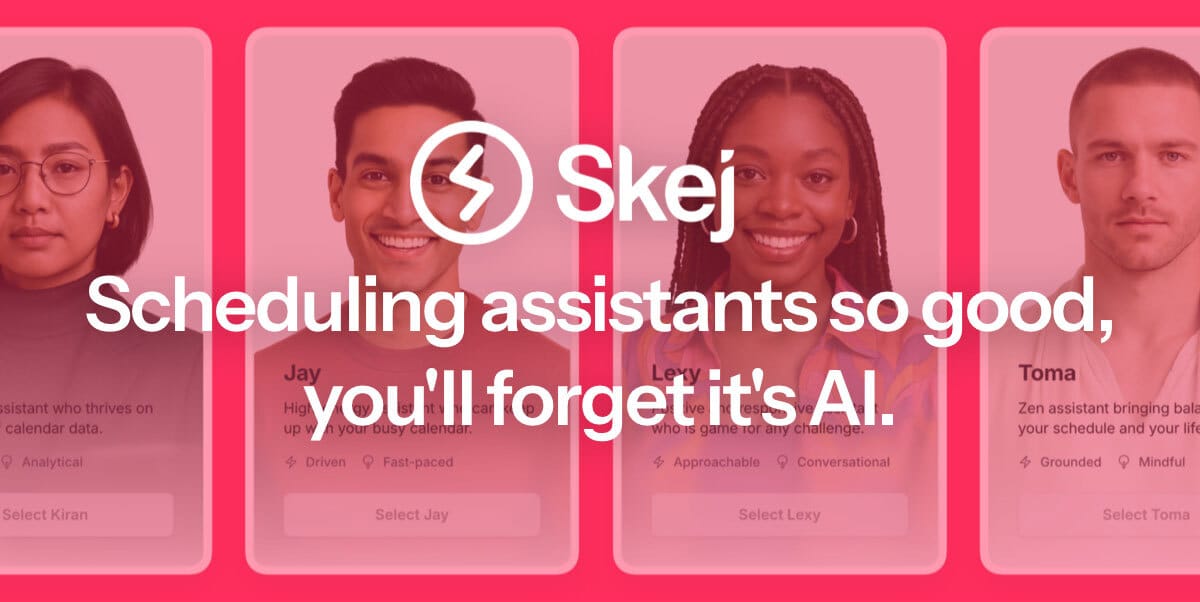- Enterprise AI Daily
- Posts
- Boring Is the New Brilliant in AI Strategy
Boring Is the New Brilliant in AI Strategy
Broadcom’s blueprint for enterprise-scale AI, newsroom chaos over bot bylines, and Google finally eats its own AI dog food

There’s a subtle but seismic shift happening in enterprise AI: the focus is moving down the stack.
While some execs are still mesmerized by model performance or auto-generated memos, leaders like Broadcom’s Purnima Padmanabhan are raising a different flag: AI infrastructure is the real competitive advantage.
Forget shiny apps. The future is federated data, coding assistants with enterprise guardrails, and application-native AI that works even in your so-called “boring” systems.
Let’s dig in.
An AI scheduling assistant that lives up to the hype.
Skej is an AI scheduling assistant that works just like a human. You can CC Skej on any email, and watch it book all your meetings. It also handles scheduling, rescheduling, and event reminders.
Imagine life with a 24/7 assistant who responds so naturally, you’ll forget it’s AI.
Smart Scheduling
Skej handles time zones and can scan booking linksCustomizable
Create assistants with their own names and personalities.Flexible
Connect to multiple calendars and email addresses.Works Everywhere
Write to Skej on email, text, WhatsApp, and Slack.
Whether you’re scheduling a quick team call or coordinating a sales pitch across the globe, Skej gets it done fast and effortlessly. You’ll never want to schedule a meeting yourself, ever again.
The best part? You can try Skej for free right now.
The Glamourless Core of AI Success
Purnima Padmanabhan, VP of Broadcom’s Enterprise Software Division, wants to talk about boring apps.
Not because they’re exciting, but because they’re what success is built on. And because at the end of the day, we all need AI to supercharge the everyday systems already running our businesses: billing, supply chain, customer portals, etc.
“Customers don’t want just fancy AI use cases,” she says. “They want AI in the everyday apps. In the boring apps that have been there for a long time.”
It’s like the office coffee machine; nobody’s impressed by it, but if it breaks, the whole place falls apart. Infrastructure may be boring, but it keeps everything running.
Here’s how they’re doing it:
1. AI + Apps + Data Must Converge
Padmanabhan argues that the real transformation comes when these three pieces are fused into one coherent stack. Their Tanzu platform plus Spring AI lets devs ship LLM-native apps fast, without abandoning legacy systems or governance.
2. Guardrails Built Into the Codebase
Their coding assistant is infused with standardized patterns and guardrails:
Repeatable code structures
Enterprise-specific compliance baked in
Secure access policies embedded at the platform level
3. Agentic AI with Real System Hooks
Enter MCP servers: reusable connectors to enterprise systems. Need an LLM to pull data from SAP, then trigger an invoice? Build a secure MCP server for that once, and reuse it across your org.
4. Vectorized Data Without the Data Lift
Broadcom’s not trying to centralize all your data. Instead, they’re building a platform that can federate, cache, vectorize, and query on the fly. Structured, unstructured, on-prem, cloud: it doesn’t actually matter.
The takeaway, in plain english for the less tech-versed:
Don’t rip out old systems, add AI where the work is already happening.
Make coding assistants follow company rules so they don’t spit out risky or inconsistent code.
Build plug-and-play connectors so AI agents can talk to existing business systems.
Keep your data where it lives, but make it searchable and usable for AI in real time.
In other words: the future of enterprise AI is about making the “boring” apps smarter, safer, and faster without breaking what already works.

Enterprise AI Daily // Created with Midjourney
News Roundup
1. Journalists Revolt Against “AI Authors”
WIRED and Business Insider staffers are in open revolt after discovering that articles are being published under AI-generated bylines like “Business Insider AI.” The move raises major ethical concerns, and exposes how murky AI authorship policies remain in media orgs.
Read more →
2. Google Shares How It Uses AI Internally
From AI-generated meeting recaps to Gemini-assisted customer support, Google is finally giving us a look under the hood. Key theme is human-in-the-loop workflows and clear disclaimers on LLM reliability. Translation: they're not blindly automating, and neither should you.
Read more →
3. Anthropic Taps Top Universities for AI Governance Initiatives
In a move that signals growing concern around responsible AI development, Anthropic is launching long-term academic partnerships with Stanford, Cornell, and Berkeley to invest in education around AI safety, ethics, and regulation.
Read more →
TL;DR:
Broadcom wants enterprises to get serious about “boring” apps; the ones AI can quietly transform at scale.
Their Tanzu + Spring AI platform supports secure, repeatable, policy-driven coding assistants.
MCP servers unlock agentic AI that actually integrates with enterprise systems.
Journalists aren’t here for AI-authored content under fake bylines. Transparency matters.
Google’s internal AI use case reveals one big thing: human oversight is still non-negotiable.
It’s time to ask yourself: are you building AI apps, or an AI foundation?
Stay sharp,
Cat Valverde
Founder, Enterprise AI Solutions
Navigating Tomorrow’s Tech Landscape Together
Your Feedback = Our FuelHow was today’s newsletter? |

